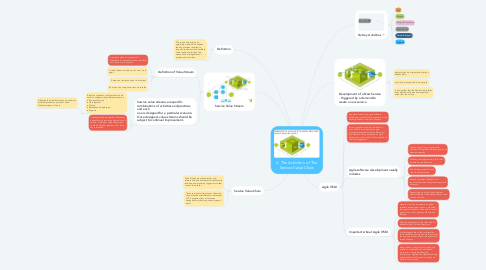
1. Definition
1.1. The service value chain, an operating model which outlines the key activities required to respond to demand and facilitate value realization through the creation and management of products and services.
2. Service Value Stream
2.1. Definition of Value Stream
2.1.1. A series of steps an organization undertakes to create and deliver products and services to consumers
2.1.2. A value stream is made up of one or more steps
2.1.3. A step can comprise one or mor actions
2.1.4. An action can comprise one or more tasks
2.2. Service value streams are specific combinations of activities and practices, and each one is designed for a particular scenario. Once designed, value streams should be subject to continual improvement.
2.2.1. Example of generic practices that can be used to support many different scenarios: • Business analysis • Development • Testing • Release and deployment • Support
2.2.1.1. Although the high-level steps are universal, different products and clients need different streams of work
2.2.2. These practices are applied differently, depending on scenario and product or service, in different value streams and combine different practices and value chain activities.
3. Service Value Chain
3.1. The activities are connected to, and interact with one another, with each activity receiving and providing triggers for further actions to be taken.
3.2. To convert inputs into outputs, the value chain activities use different combinations of ITIL practices (sets of resources designed for performing certain types of work).
4. Six Key Activities
4.1. Plan
4.2. Engage
4.3. Design & Transition
4.4. Obtain/build
4.5. Deliver &Support
4.6. Improve
5. Development of a New Service - Triggered by a demand to create a new service
5.1. demand may be originated by various stakeholders
5.2. and can be recognized in many ways
5.3. it is important that the demand articulates both desired outcomes and expected value from the service
6. Agile ITSM
6.1. If applied successfully, agile software development enables fast responses to the evolving needs of service consumers.
6.2. For an organization to be successful, it must be able to adapt to changing circumstances while remaining functional and effective. Many principles of Agile development can and should be applied to service management.
6.3. Agile software development usually includes
6.3.1. Continually evolving requirements, collected through feedback analysis and direct observation
6.3.2. Breaking development work into small increments and iterations
6.3.3. Establishing product-based cross-functional teams
6.3.4. Visually presented (Kanban) and regularly discussed (daily stand-ups) work progress
6.3.5. Presenting a working (or the minimum viable) software to the stakeholders at end of each iteration.
6.4. Important About Agile ITSM
6.4.1. However, in many organizations, agile software development has not provided the expected benefits, often due to lack of agility in the other phases of the service lifecycle.
6.4.2. Overall performance of the value chain is defined by that of the slowest part
6.4.3. A holistic approach to the service value chain should be adopted to make sure that the service provider is agile throughout the service lifecycle.
6.4.4. If adopted as a key principle, agility can enable an organization to survive and prosper in a constantly changing environment. Applied in a fragmented way, agile methods can become a costly and wasteful complication.
